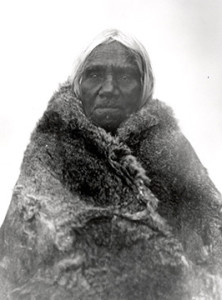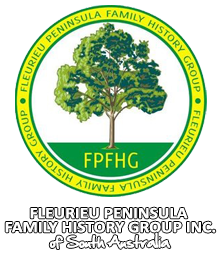Indigenous Heritage
Warning for Indigenous Visitors!!
Portions of this section of our website may contain images of deceased persons.
Contrary to popular belief, there are several groups of indigenous people who have called the Fleurieu home over the centuries. Most notably, these include the Kaurna, Ngarrindjerri, Ramindjeri and the Peramangk. There were other groups too, including Ngarallta, Nganguruku, Jarildekald, Padnaindi and others.
The Kaurna People

Pictured: Ivaritji – the last surviving full blood Kaurna woman.
The Kaurna people roamed most of the area of the Fleurieu Peninsula for thousands of years. Their area stretched from the tip of Cape Jervis north as far as Port Wakefield along the eastern shore of St Vincent’s Gulf and east to an area somewhere between Mt Lofty and Mt Barker.
The name Kaurna is pronounced either “Garner” or “Gowna” depending on which end of their land you might come from. In 1842, it was reported in The Register that there were only 650 true Kaurna people left in the Colony. The last surviving female full blood Kaurna woman, Ivaritji, died in 1931, but provided Indigenous Anthropologists with a good deal of what we know of the early Kaurna people today. There are still many people living on the Fleurieu who claim Kaurna ancestral heritage.
The Ngarridjeri People

Closer to Lake Albert and Lake Alexandrina, lived the Ngarrindjeri people. Their lands included the areas around Goolwa, Hindmarsh Island, Point Macleay and other places. These people, according to the Anthropologist Norman Tindale, were closely related to the Ramindjeri people.
A good many Ngarrindjeri people may still be found in various areas around the state, but many live in the Murray Bridge, Point Macleay and Point Sturt areas and on the Coorong.
The Ramindjeri People
 The Ramindjeri people lived at Encounter Bay and around Cape Jervis. Their name for Encounter Bay and Victor Harbor was Ramong. It is believed that these were considerably more hostile towards the white man than many of the other groups encountered on the coastal areas of St Vincent’s Gulf and east to the lakes.
The Ramindjeri people lived at Encounter Bay and around Cape Jervis. Their name for Encounter Bay and Victor Harbor was Ramong. It is believed that these were considerably more hostile towards the white man than many of the other groups encountered on the coastal areas of St Vincent’s Gulf and east to the lakes.
The Peramangk People
 In the Mt Lofty Ranges, around Mt Barker and down as far as Wellington and Myponga, lived the Peramangk people. They were feared by some of the other groups of people, since they practiced circumcision, and this was seen as some for of devilry by the other groups.
In the Mt Lofty Ranges, around Mt Barker and down as far as Wellington and Myponga, lived the Peramangk people. They were feared by some of the other groups of people, since they practiced circumcision, and this was seen as some for of devilry by the other groups.
Doreen Kartinyeri (1989, Aboriginal Heritage Branch)
The late Doreen Kartinyeri wrote in a paper relating to the Peramangk in 1989:-
“Conflicting reports show antagonism between the three tribes of the Adelaide region – the Kaurna, the Ngarrindjeri and the Peramangk, but other reports state that the Peramangk were held with some reverence due to their differing cultural practices, the most different of those being the fact that they practised circumcision among their male population.
The numbers of people and their traditional practises are hard to verify, as shortly after the European settlement of the Adelaide Hills, especially in Mount Barker, and Hahndorf, the Peramangk had been thought to have been wiped out by introduced diseases, but records show that they were in fact settled at Poonindee, Moorundie, Wellington, and later at Point Pearce and Point McLeay.”
The Portaulan People
 This smaller group of people lived in the general area of Wellington, although they ranged as far afield as Wood Hill, Pomonda Point and Grote Hill. The last full blooded member of this group was David Ngunaiponi who died in 1967.
This smaller group of people lived in the general area of Wellington, although they ranged as far afield as Wood Hill, Pomonda Point and Grote Hill. The last full blooded member of this group was David Ngunaiponi who died in 1967.
The gentleman pictured here is James Unaipon (James Nguaiponi) father of David Ngunaiponi (Unaipon) mentioned here.
The Ngaralta People
Another smaller group of people, who may have shared their lands with the Peramangk and the Portaulan people, were the Ngaralta, who lived in the general area of the Bremer Creek, Red Creek and Callington. These people often made their camp along the Bremer near to where the Salem Church now stands, and would travel in later years to the edge of the town of Callington to receive their blankets, flour and tobacco provided for them by the Protector of Aborigines. My own family history contains some anecdotal stories of these people and their interaction with the European community.
European Treatment of Aboriginal People
In many cases, the treatment of Aboriginal people by the early European settlers was barbaric to say the least, but there were a few cases of white men helping the people out with work and food and other good deeds. Not so was the case with many of the police troopers and later the Protectors of Aborigines.
In 1844 the Protector of Aborigines was made the legal guardian of every Aboriginal child whose parents were either dead or unknown in South Australia (and in the Northern Territory which was part of SA up until about 1910). A year later, in 1845, the Protector – then, Matthew Moorhouse, set up a school on the site of the present day Migration Museum to teach Aboriginal children. But it was more the case of ‘training and civilising’ than that of teaching them anything. In 1911 the Chief Protector of Aborigines was given even greater power over the well being of Aboriginal children. He now had the power of Legal Guardian of every Aboriginal child under the age of 21, and had the power to determine where those children lived, whether they had living relatives or not. By 1923 the Protector’s powers had grown again, this time to include the removal of children from their families for any reason he deemed fit. An Aboriginal child did not need to have been neglected or in need, did not need to have no living relatives, but simply because they were Aboriginal, gave the Protector the right to remove them. Between 1934 and 1939 the role of the single Protect was abolished and a Protection Board was enacted to oversee the institutional training of Aboriginal children. This was to continue until around 1962, when the Act was again repealed and the children in care or in Government run institutions were brought under the same welfare care as non- Aboriginal children. It took until 1967 for Aboriginal people to be counted in the Australian Census, and to be given the right to vote at elections. It took another 30 years before the Government began to take any notice of the recommendations of the many inquiries into the separation of children from their families. It was not until 1997 that the Human Rights and Equal Opportunity Commission made their submission of 54 points of recommendation including compensation, acknowledgement, repatriation and apology to the Government. It took another 11 years for the Australian Government to make that apology – Prime Minister Kevin Rudd delivered the apology speech in Canberra in April 2008 – it has been a long time coming.
Tracing Your Indigenous Heritage
Do you have Indigenous ancestry in your blood lines and want to know more about where your people came from? Then a visit to the State Records Office at Gepps Cross is well worth the effort.
The State Records website has some useful information to assist in getting started.
You can also contact their Aboriginal Services section at –
Aboriginal Access Team
GPO Box 1072
Adelaide, SA, 5001
Phone – 08 8343 6820
Fax – 08 8204 8798
Email – srsaAboriginalServices@saugov.sa.gov.au
The Gepps Cross Research Centre
115 Cavan Road
Gepps Cross, SA, 5094
Phone 08 8226 7750
The centre is open from 9:00 – 3:30 Tuesday to Friday, and from 11:00 – 5:00 on the first Sunday of each month. They are closed on Mondays, Saturdays and Public Holidays.
The City Research Centre
26-28 Leigh Street
Adelaide, SA, 5000
Phone 08 8226 7750
This centre is open from 9:00 – 3:30 Tuesday to Friday. They are closed on Mondays, Weekends and Public Holidays.
State Records also produces a range of research resources to assist in your search including – A Little Flour & A Few Blankets
SA Link Up
Members of the Stolen Generations may find the services of SA Link Up very useful in reuniting with they traditional families. This group is well set up to assist you in any way they can to reunite with your traditional family.
SA Link Up produces many good resources for researchers including –
Aboriginal Missions in South Australia
Finding Your Own Way Directory
Why Me? – a film featuring five Aboriginal people who were removed from their families.
